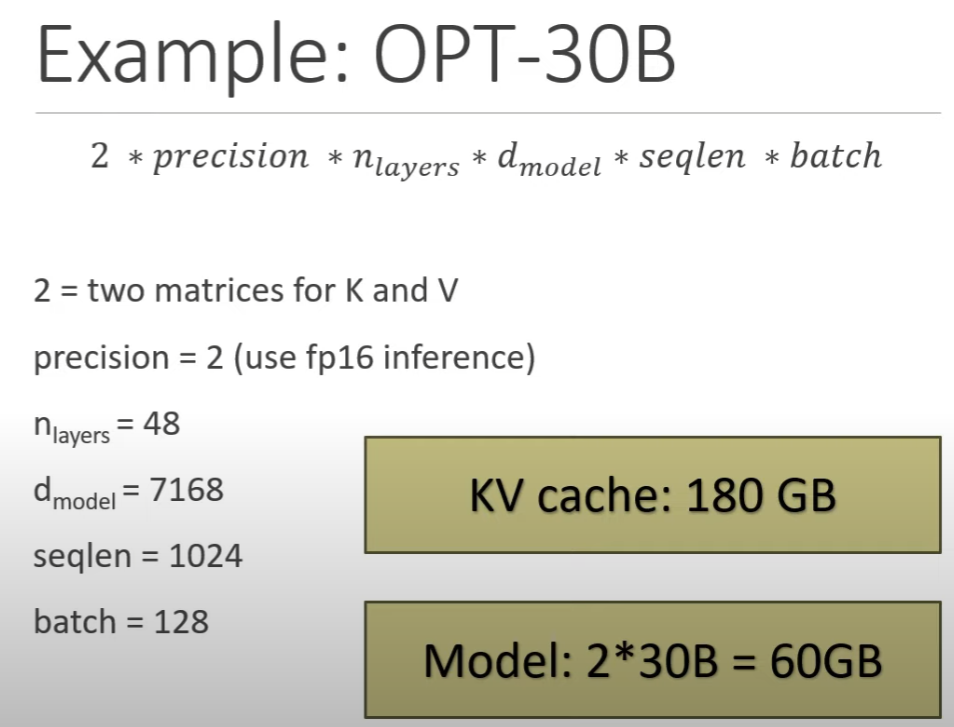Source
- 【手撕LLM-KVCache】顯存刺客的前世今生–文末含代碼 - 知乎 (zhihu.com)
- 大模型推理性能優化之KV Cache解讀 - 知乎 (zhihu.com)
- The KV Cache: Memory Usage in Transformers https://www.youtube.com/watch?v=80bIUggRJf4&ab_channel=EfficientNLP
- [LLM]KV cache詳解 圖示,顯存,計算量分析,代碼 - 知乎 (zhihu.com)

1. KV Cache是啥?
大模型推理性能優化的一個常用技術是KV Cache,該技術可以在不影響任何計算精度的前提下,通過減少計算提高推理性能。但是沒有白喫的午餐,需要更多的內存空間做爲 KV cache.
2. 背景
生成式generative模型的推理過程很有特點,我們給一個輸入文本 (長度為 $s$),模型會輸出一個回答(長度爲 $n$),其實該過程中執行了$n$ 次推理 (inference) 過程。即GPT類模型一次推理只輸出一個token,輸出token會與輸入tokens 拼接在一起,然後作爲下一次推理的輸入,這樣不斷反覆直到遇到終止符。
如上描述是我們通常認知的GPT推理過程。代碼描述如下:
1 | |
輸出
1 | |
可以看出如上計算的問題嗎?每次推理過程的輸入tokens都變長了 ($n_{ctx}$),導致推理FLOPs隨之增大。有方法實現推理過程的FLOPs基本恆定不變或變小嗎?(埋個伏筆,注意是基本恆定)。
3. 原理
b: batch
s: sequence (context) length
h: model input dimension
在上面的推理過程中,每 step 內,輸入一個 token序列,經過Embedding層將輸入token序列變爲一個三維張量[b, s, h],經過一通計算,最後經logits層將計算結果映射至詞表空間,輸出張量維度爲[b, s, vocab_size]。
以上 GPT2 code 爲例: b = 1; s 會每次加 1, 最大到 $n_{ctx}$ ; h = 768; vocab_size = 50257
當前輪輸出token與輸入tokens拼接,並作爲下一輪的輸入tokens,反覆多次。可以看出第 $i+1$ 輪輸入數據只比第 $i$ 輪輸入數據新增了一個token,其他全部相同!因此第 $i+1$輪推理時必然包含了第 $i$ 輪的部分計算。
從 attention block 的角度來看,就是下面的 $x_i : [b, s, h]$ 到下次 $x_{i+1} : [b, s+1, h]$ 每次 token 長度都會加一。計算量也會變大。
step $i$:
- 計算 Q, K, V: input 和 output shape at i step: $[b, s, h] \times [h, h] \to [b, s, h]$
- 計算 $Q K^T$ 矩陣的 input 和 output $ [b, head_{num}, s, d_{head}] \times [b, head_{num}, s, d_{head}] \to [b, head_{num}, s, s]$
step $i+1$:
- 計算 Q, K, V: input 和 output shape at i+1 step: $[b, s+1, h] \times [h, h] \to [b, s+1, h]$
- 計算 $Q K^T$ 矩陣的 input 和 output $ [b, head_{num}, s+1, d_{head}] \times [b, head_{num}, s+1, d_{head}] \to [b, head_{num}, s+1, s+1]$

開始是 $s=1, 2, …$, 直到最後 $s = n_{ctx}$ (maximum context length, GPT2 = 1024). 此時已到達 sequence lengthh 的上限 . 接下來每次進來的 token 都會 shift 掉一個最前面的 token. 也就是 $x_{i+1}$ 是 shifted $x_i$.
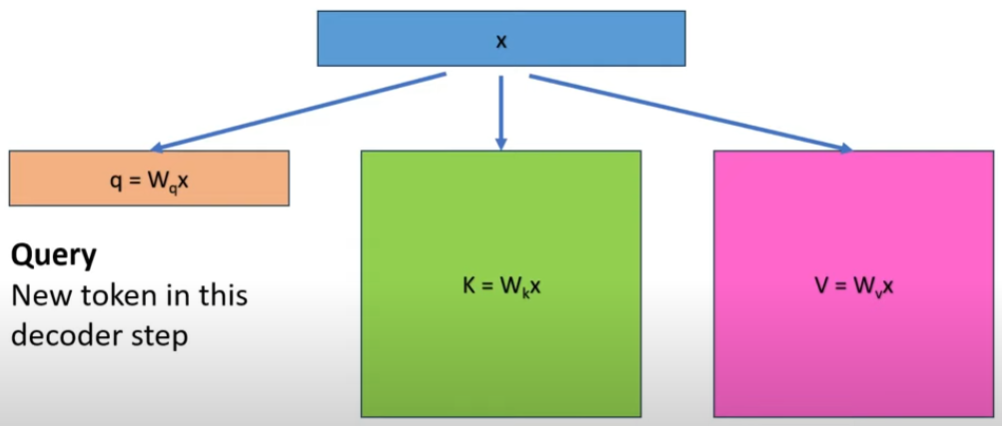
最暴力的方法是每次都計算大的矩陣乘法。但是如果我們可以緩存前一次的 (key, value) 值。是否可以減少重算下一次的 (key, value)?
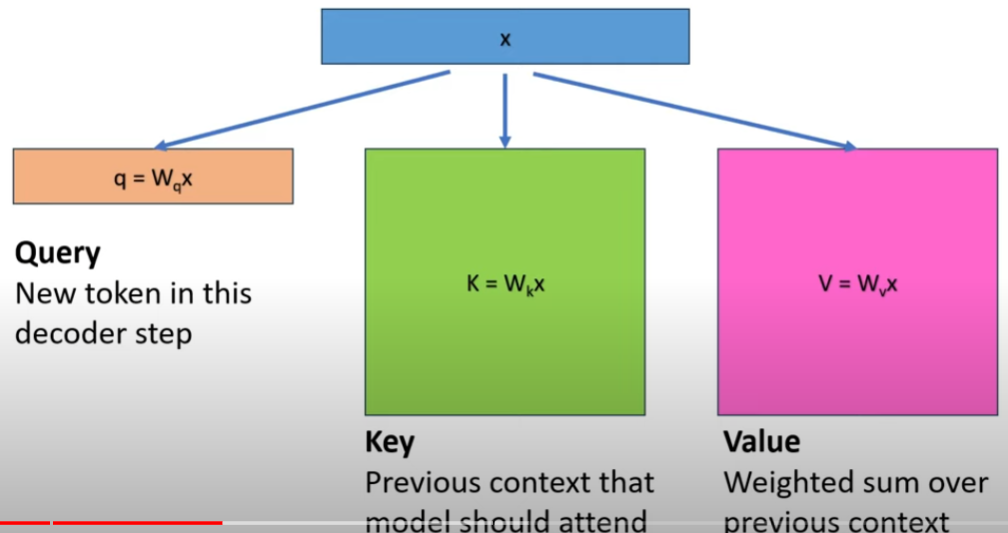
KV Cache的出發點就在這裏,緩存當前輪可重複利用的計算結果,下一輪計算時直接讀取緩存結果,就是這麼簡單,不存在什麼Cache miss問題。
SM stands for SoftMax.
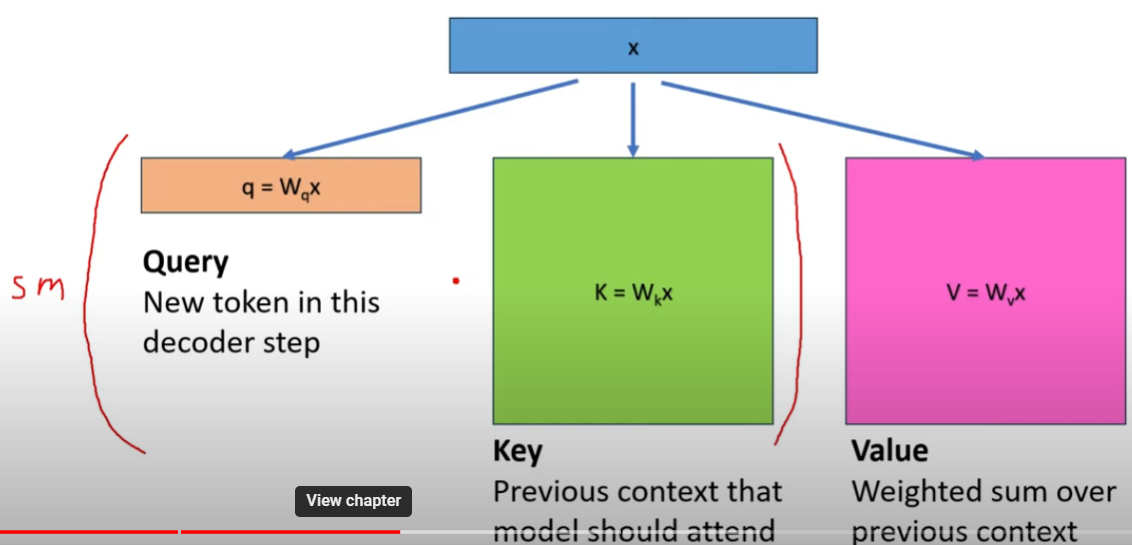
例如在輸入新的 token “chill”,之前的 “cold” 對應的 K vector 和 attention score (V) 其實都不用重算。只需要計算新的 “chill” 對應的 vector 和 attention score (K, V)

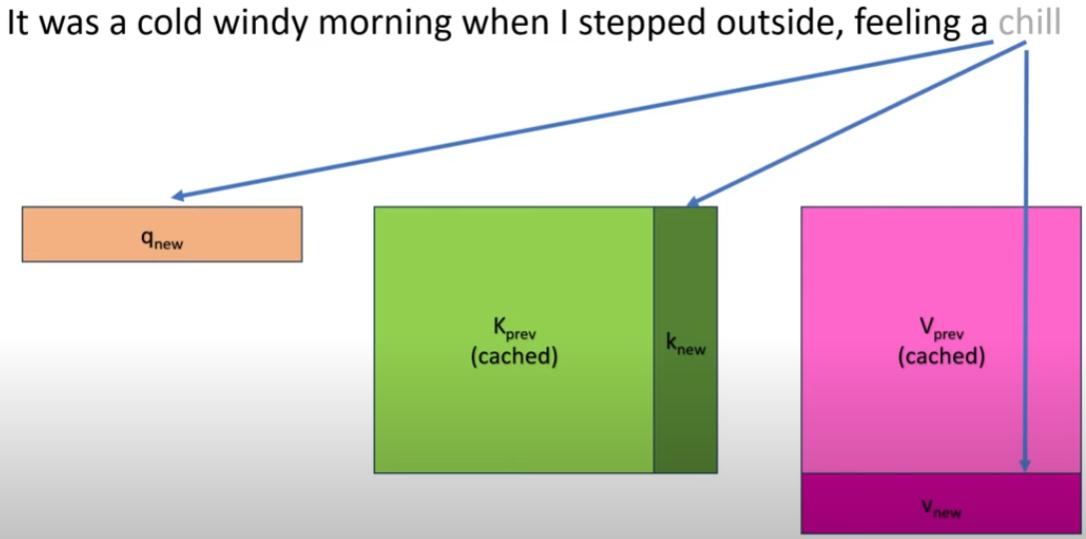
問題:緩存的做法是否可以用在 FFN (feedforward block)? 好像不行? 因爲 FFN input vector shift 之後對應的 weights 就會完全不同?可是 attention 對應的 score 是 position independent? 只有 Attention 有 context and KV cache gain!
KV Cache Memory Usage:
KV parameter count: $2 b s h l$; Memory size: $2 bshl \text{ *precision}$
-
第一個 2 是 two matrices for K and V
-
b: batch. 一般 b = 1.
-
s: context length. 一般 1024
-
l: transformer 層數,每一層都有一個 KV cache
-
h: dimension.
-
Precision 是多少 byte, INT8 precision = 1; FP16 precision = 2
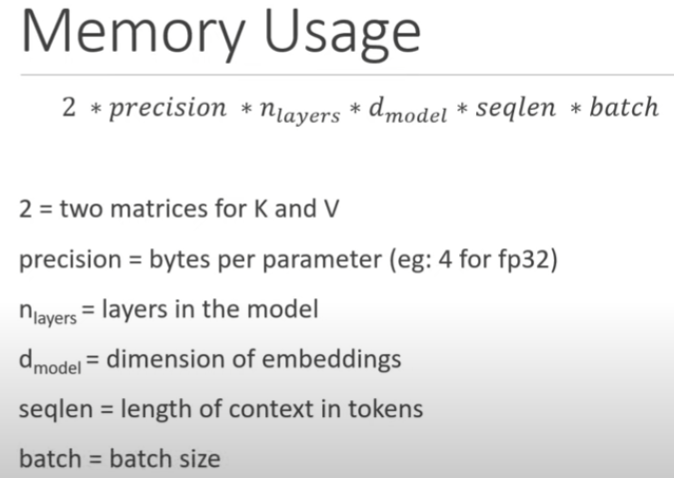
實現細節
目前各大模型推理都實現了KV Cache,下面就看如何使用了。我們可以在上面代碼基礎上修改,主要改動:
- 在推理時新增了 past_key_values 參數,該參數就會以追加方式保存每一輪的K V值。kv cache變量內容爲((k,v), (k,v), …, (k,v)),即有 $n_{layers}$ 個 k,v 組成的一個元組,其中 k 和 v 的維度均爲 $[b, n_{head}, s, d_{head}]$。這裏可以順帶計算出每輪推理對應的 cache 數據量爲 2∗b∗s∗ℎ∗$n_{layers}$ ,這裏 s 值等於當前輪次值。以GPT3-175B爲例,假設以 float16 來保存 KV cache,senquence長度爲100,batchsize=1,則 KV cache佔用顯存爲 2×100×12288×96×2 Byte= 472MB。
- 推理輸出的token直接作爲下一輪的輸入,不再拼接,因爲上文信息已經在 kvcache 中。
代碼示例:
1 | |
通過上面代碼只能看到調用層面的變化,實現細節還需看各框架的底層實現,例如Hugging Face的transformers庫代碼實現就比較清爽,在modeling_gpt2.py中Attention部分相關代碼如下:
1 | |
其實,KV Cache 配置開啓後,推理過程可以分爲2個階段:
- 預填充階段 ($s = 1,2, .., n_{ctx}$):發生在計算第一個輸出token過程中,這時Cache是空的,計算時需要爲每個 transformer layer 計算並保存key cache和value cache,在輸出token時Cache完成填充;FLOPs同KV Cache關閉一致,存在大量 GEMM 操作,推理速度慢。 正常推理,預存 key-value cache;compute-bound 計算
- 使用KV Cache階段:發生在計算第二個輸出token至最後一個token過程中,這時Cache是有值的,每輪推理只需讀取Cache,同時將當前輪計算出的新的Key、Value追加寫入至Cache;FLOPs降低,GEMM 變爲 GEMV 操作,推理速度相對第一階段變快,這時屬於Memory-bound類型計算。memory-bound 計算
這裏用圖可能更有助理解,下圖是一個Decoder Block,含有Self-Attention和MLP,標紅部分爲KV Cache影響到的內容,即KV Cache開啓後,標紅的序列長度 s 變爲 1,當batch_size=1時,Self-Attention中的2個dense全都變爲gemv操作,MLP中的dense也全都變爲gemv操作。看懂這個圖就可以答對上面的3個問題啦。

總結
KV Cache是Transformer推理性能優化的一項重要工程化技術,各大推理框架都已實現並將其進行了封裝(例如 transformers庫 generate 函數已經將其封裝,用戶不需要手動傳入past_key_values)並默認開啓(config.json文件中use_cache=True)。
更多例子
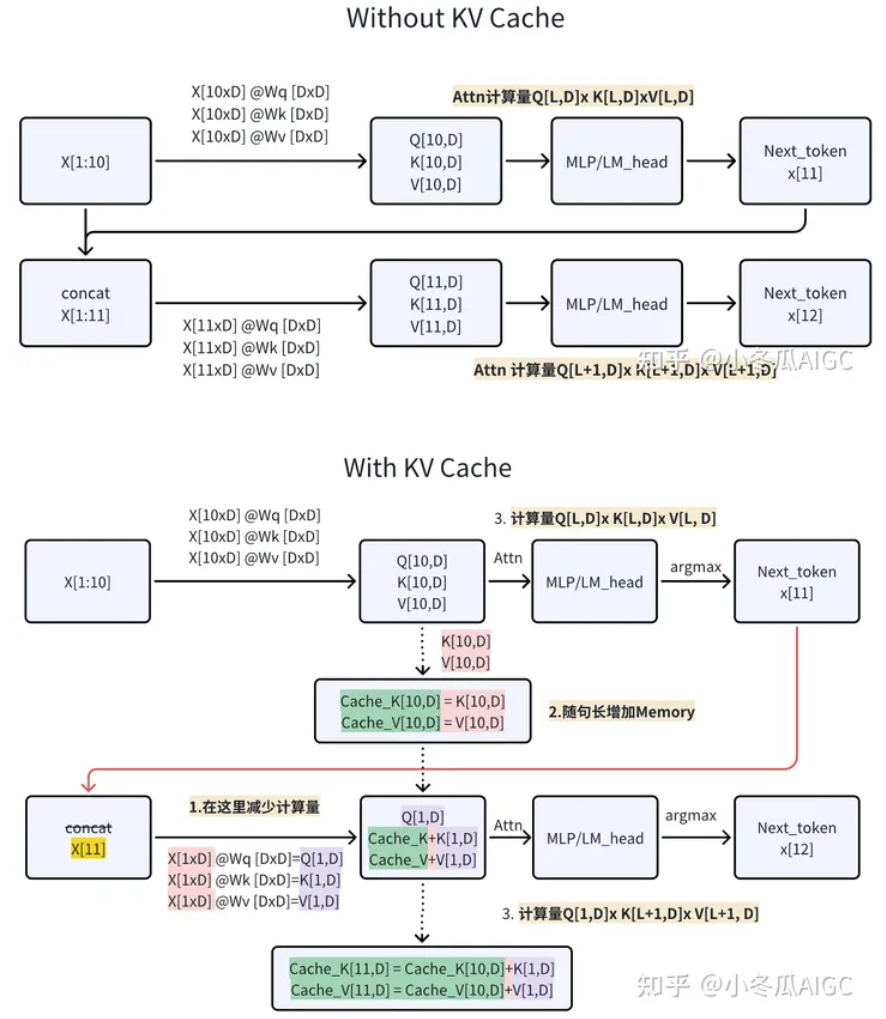
無 KV-Cache 的例子
1 | |
結果是
1 | |
有 KV-Cache 的例子
1 | |
1 | |
NanoGPTplus 例子
1 | |
檢查 idx, kv_cache, context 的 shape (dimension)
- idx : (batch, seq_len): batch =1 而且 seq_len 每次加 1.
- kv_cache: (k/v, batch, num_head , seq_len, head_dim) = (2, 1, 12, s, 64)
KV cache 額外的顯存佔用分析
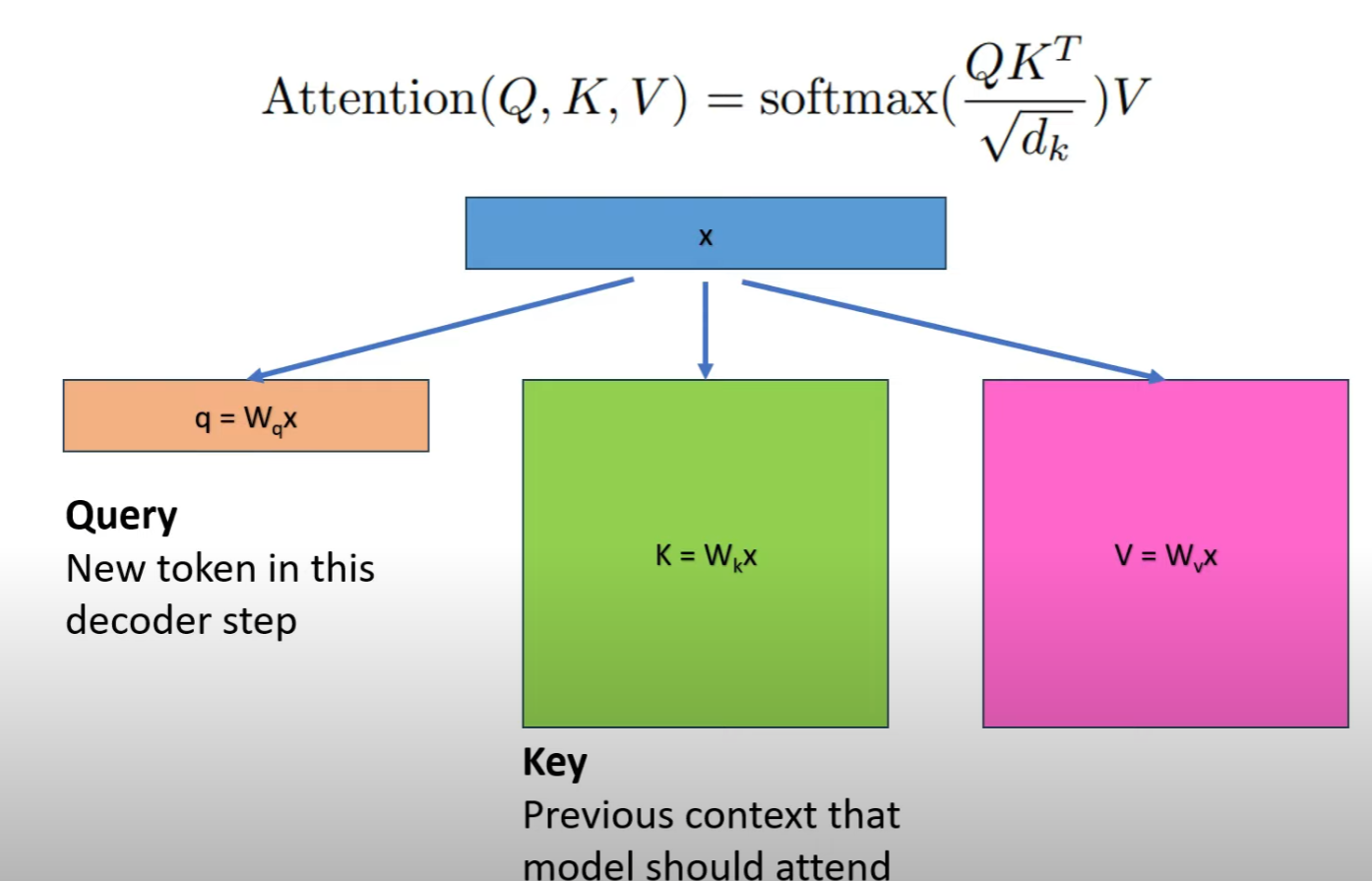
-
存儲 kvlength 個K|V value,形狀爲 [b, head_num, kv_seq_len, head_dim],
-
顯存佔用爲: 4blh(kv_length)
假設輸入序列的長度爲 $s$,輸出序列的長度爲 $n$,以float16來保存KV cache,那麼KV cache的峯值顯存佔用大小爲 $b(s+n)hl2*2 = 4blh(s+n)$。這裏第一個2表示K/V cache,第二個2表示float16佔2個bytes。
- Training 的中間激活時 : $34 blsh + 11 b l s^2 a$, KV cache 只存了 attention 中的 K and V 部分,有包含 score?
- Model 參數量是 $12 l h^2$ (和 b, s 無關!), 假設是 16-bit, Model 內存是 $24 l h^2$
- 假設 inference $b=1$ (這不一定是對的,在 speculative decode, 大 model 的 $b > 1$, no, speculative decode batch=1, 不過一次可以 take multiple tokens for verification): KV cache : $4 blh (s+n)$. KV cache / model parameter ~ $b (s+n) / 6 h$! 對於 long context, $s + n$ 可能會大於 $h$!! $s$ 就是 $n_{ctx}$, $h$ 就是 $d_{model}$
- 以 Llama2-7B 爲例, $h = 4096$, 但是 $n_{ctx} 最大也有 4096$!
Example Llama2 (4A16W)
以 Llama2-7B 爲例。
| 模型名 | 參數量 | 層數, l | 隱藏維度, h | 注意力頭數 a | Context s |
|---|---|---|---|---|---|
| Llama2-7B | 7B | 32 | 4096 | 32 | 4096 |
| Llama2-13B | 13B | 40 | 5120 | 40 | 4096 |
| Llama2-33B | 33B | 60 | 6656 | 52 | 4096 |
| Llama2-70B | 70B | 80 | 8192 | 64 | 4096 |
Llama2 的模型參數量爲7B,佔用的顯存大小爲 (INT8) 7Bx2 = 7GB 。假設 activation 是 FP16.
假設 Llama2 的序列長度 $s$ 爲 2048 。對比不同的批次大小 $b$ 佔用的中間激活:
當 b=1 時,KV cache 佔用顯存爲 $(4bsh)*l$ byte ≈1GB ,大約是模型參數顯存的15%。
假設 Llama2 的序列長度 $s$ 爲 4096 。對比不同的批次大小 $b$ 佔用的中間激活:
當 b=1 時,KV cache 佔用顯存爲 $(4bsh)*l$ byte ≈2.1GB ,大約是模型參數顯存的31%。
如果 model 是 4-bit (4W16A) 7Bx0.5 = 3.5GB, 更糟糕: KV cache 佔的比例 double.
Example GPT3-175B (8A16W)
以GPT3-175B爲例,我們來直觀地對比下模型參數與中間激活的顯存大小。GPT3的模型配置如下。我們假設採用混合精度訓練,模型參數和中間激活都採用float16數據類型,每個元素佔2個bytes。
| 模型名 | 參數量 | 層數, l | 隱藏維度, h | 注意力頭數 a |
|---|---|---|---|---|
| GPT3 | 175B | 96 | 12288 | 96 |
GPT3的模型參數量爲175B,佔用的顯存大小爲 1×175B = 175GB for inference。
GPT3的序列長度 $s$ 爲 2048 。對比不同的批次大小 $b$ 佔用的中間激活:
b=1 ,輸入序列長度 s=2048, 中間激活佔用顯存爲 $(4bsh)*l$ byte ≈9.7GB ,大約是模型參數顯存的 5.6%。
b=64 ,輸入序列長度 s=512 ,輸出序列長度 n=32 ,則KV cache佔用顯存爲 $4blh(s+n) = 164 GB$,大約是模型參數顯存的 1 倍。
